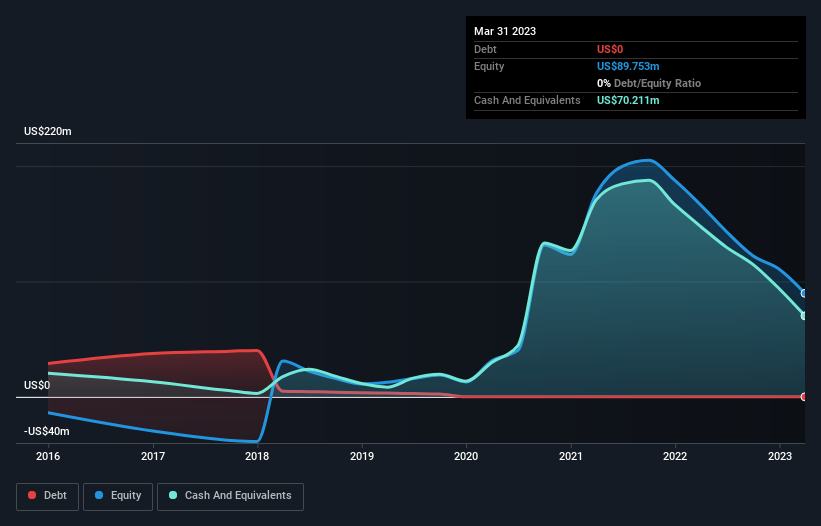Here's Why We're A Bit Worried About Vaxart's (NASDAQ:VXRT) Cash Burn Situation
There's no doubt that money can be made by owning shares of unprofitable businesses. For example, although Amazon.com made losses for many years after listing, if you had bought and held the shares since 1999, you would have made a fortune. But while the successes are well known, investors should not ignore the very many unprofitable companies that simply burn through all their cash and collapse.
So should Vaxart (NASDAQ:VXRT) shareholders be worried about its cash burn? For the purposes of this article, cash burn is the annual rate at which an unprofitable company spends cash to fund its growth; its negative free cash flow. First, we'll determine its cash runway by comparing its cash burn with its cash reserves.
View our latest analysis for Vaxart
Does Vaxart Have A Long Cash Runway?
A cash runway is defined as the length of time it would take a company to run out of money if it kept spending at its current rate of cash burn. When Vaxart last reported its balance sheet in March 2023, it had zero debt and cash worth US$70m. Importantly, its cash burn was US$104m over the trailing twelve months. That means it had a cash runway of around 8 months as of March 2023. Importantly, analysts think that Vaxart will reach cashflow breakeven in 5 years. Essentially, that means the company will either reduce its cash burn, or else require more cash. The image below shows how its cash balance has been changing over the last few years.
How Is Vaxart's Cash Burn Changing Over Time?
In our view, Vaxart doesn't yet produce significant amounts of operating revenue, since it reported just US$697k in the last twelve months. Therefore, for the purposes of this analysis we'll focus on how the cash burn is tracking. Over the last year its cash burn actually increased by 40%, which suggests that management are increasing investment in future growth, but not too quickly. That's not necessarily a bad thing, but investors should be mindful of the fact that will shorten the cash runway. While the past is always worth studying, it is the future that matters most of all. For that reason, it makes a lot of sense to take a look at our analyst forecasts for the company.
How Easily Can Vaxart Raise Cash?
Since its cash burn is moving in the wrong direction, Vaxart shareholders may wish to think ahead to when the company may need to raise more cash. Generally speaking, a listed business can raise new cash through issuing shares or taking on debt. Many companies end up issuing new shares to fund future growth. We can compare a company's cash burn to its market capitalisation to get a sense for how many new shares a company would have to issue to fund one year's operations.
Since it has a market capitalisation of US$167m, Vaxart's US$104m in cash burn equates to about 62% of its market value. That's very high expenditure relative to the company's size, suggesting it is an extremely high risk stock.
How Risky Is Vaxart's Cash Burn Situation?
We must admit that we don't think Vaxart is in a very strong position, when it comes to its cash burn. Although we can understand if some shareholders find its increasing cash burn acceptable, we can't ignore the fact that we consider its cash burn relative to its market cap to be downright troublesome. Shareholders can take heart from the fact that analysts are forecasting it will reach breakeven. After considering the data discussed in this article, we don't have a lot of confidence that its cash burn rate is prudent, as it seems like it might need more cash soon. On another note, we conducted an in-depth investigation of the company, and identified 5 warning signs for Vaxart (2 shouldn't be ignored!) that you should be aware of before investing here.
Of course Vaxart may not be the best stock to buy. So you may wish to see this free collection of companies boasting high return on equity, or this list of stocks that insiders are buying.
Have feedback on this article? Concerned about the content? Get in touch with us directly. Alternatively, email editorial-team (at) simplywallst.com.
This article by Simply Wall St is general in nature. We provide commentary based on historical data and analyst forecasts only using an unbiased methodology and our articles are not intended to be financial advice. It does not constitute a recommendation to buy or sell any stock, and does not take account of your objectives, or your financial situation. We aim to bring you long-term focused analysis driven by fundamental data. Note that our analysis may not factor in the latest price-sensitive company announcements or qualitative material. Simply Wall St has no position in any stocks mentioned.
Join A Paid User Research Session
You’ll receive a US$30 Amazon Gift card for 1 hour of your time while helping us build better investing tools for the individual investors like yourself. Sign up here

